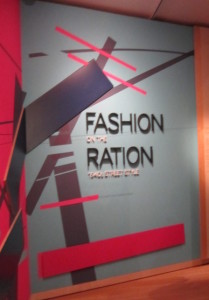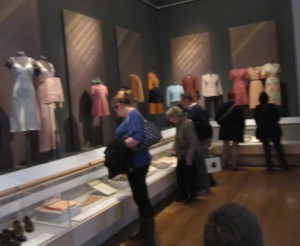…. is the name of a newly opened exhibition at the Imperial War Museum ( North Lambeth tube, Bakerloo line ) which I visited yesterday. Up on the third  level, it shows off the museum’s collection of Second World War clothing, of all types and shapes, not just uniforms, although they play a part.
level, it shows off the museum’s collection of Second World War clothing, of all types and shapes, not just uniforms, although they play a part.
I benefitted from the company of an 88 year old former seamstress who was 15 in 1942 and worked in a garment factory until the late 1940s. She recalled many of the items of clothing on show – for all were standardised, in cut, fabric and trimming. The ‘girls’ were expected to sew prodigious amounts – sixty pairs of boy’s short trousers a day, for example. They dreaded making the Royal Navy uniforms, because the cloth known as ‘Melton Navy’ had such a long nap that, at the end of each day, the seamstresses’ hair would be full of fluff from the fabric. Not easy to wash out in war-time, when there was no such thing as shampoo and soap was strictly rationed. Nonetheless, she and her colleagues managed to cloth most of their menfolk with off-cuts and ‘seconds’ and would swap their skills for other fabrics, like ‘parachute silk’ – not silk at all, but nylon or rayon – to better cloth themselves. This became widely available after 1945 and, apparently, many a wedding dress was made of it.
There are audio interviews to give background to war-time life and tell how individuals managed to keep up appearances. Life was hugely restricted, as one would expect, but this continued for years afterwards. The seamstress told how she was fined £100 ( a very large sum in the 1940s ) for daring to change jobs, moving from one factory to another. Fortunately, the new factory was a food producer, so she was exempted  from payment, as this work was considered to be as important as making uniforms. This all happened several years after the war was over. I, for one, was unaware of this continuing level of state control over the lives of ordinary people, although I knew that rationing continued well into the 1950s.
from payment, as this work was considered to be as important as making uniforms. This all happened several years after the war was over. I, for one, was unaware of this continuing level of state control over the lives of ordinary people, although I knew that rationing continued well into the 1950s.
The exhibition, while of interest, didn’t tell me much that I didn’t know already – our cinema and TV have often showcased and documented the 1940s – and I found it less engaging that the same museum’s War-time Childhood exhibition of some years ago. This is one for folk interested in the history of clothing and fashion perhaps, rather than of more general interest. Tickets are £10 each, £5 for children and £7 concessions. Whilst this isn’t a huge amount and I appreciate that to arrange and curate such exhibitions costs money, when compared with the free exhibition of WWI paintings  which I saw recently at the same museum, this seemed quite a lot, especially for families. Whilst waiting at the entrance I saw two families turn away when they realised that the exhibition, unlike the museum, was not free. Maybe they weren’t that interested, or perhaps it was a sign of our, similarly austere, times.
which I saw recently at the same museum, this seemed quite a lot, especially for families. Whilst waiting at the entrance I saw two families turn away when they realised that the exhibition, unlike the museum, was not free. Maybe they weren’t that interested, or perhaps it was a sign of our, similarly austere, times.


 RSS – Posts
RSS – Posts